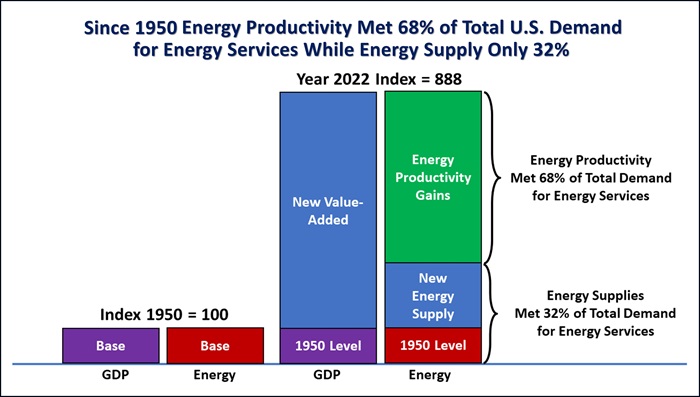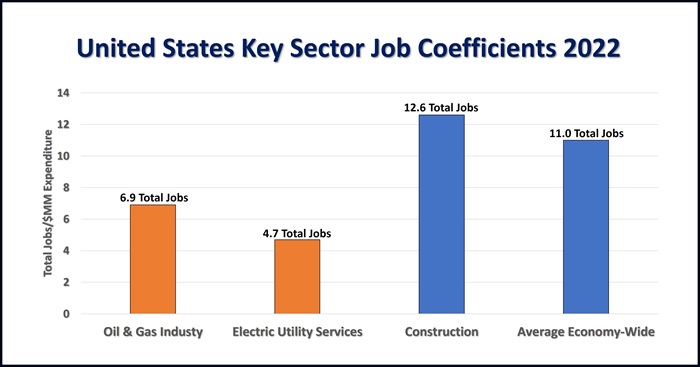Apr 26, 2024
Looking at Jobs Can Change Our Minds About Energy
For every $1 million of avoided oil and gas industry costs, which drives a total of 6.9 jobs, the energy-bill savings spent throughout the economy could drive 11 total jobs. The net gain is 4.1 jobs.
By: John A. “Skip” Laitner

Energy jobs? U.S. citizens usually don’t give energy much thought… except as we might worry about the price of gasoline or the monthly electricity bill. Yes, we might also fret a little as we think about how fossil fuels contribute to the growing burden of climate change.
A Shift in Perspective
There is so much more to the energy-jobs story than is generally understood. This is especially true as engineers, materials scientists, and even energy and resource economists are coming up with new critical insights on how energy shapes our larger social and economic well-being, as well as the climate and growing environmental burdens.
I have great hope that “rethinking the energy narrative” might positively enhance a more robust and sustainable economy. In the brief account that follows, I’ll lay out working examples of how a deeper understanding of jobs might change our minds about the nation’s energy consumption as it enables the greater good.
Looking at jobs figures can give us reasons for both caution and optimism.
Energy Enables Work
On any given day, someone may be welding together critical parts of an infrastructure that will generate a useful amount of solar-powered electricity. At the same time, a plant foreman may power up equipment to meet the day’s production schedule. A truck driver may be on her way to deliver a replacement part that allows a manufacturer to resume production.
These separate work events all share three critical ingredients. The first is someone who performs work or who directs an activity that gets the job done (labor). The second is the use of machinery or equipment that enables the production of goods and services (capital). The last is a flow of energy so that the desired work can be carried out (useful energy as work).
In effect, both labor and capital absolutely require energy in order to function at all. But it is not purely the availability of energy that matters, but how productively we put that energy to work.
In fact, as Figure 1 suggests, since 1950, the U.S. economy has grown by a factor of almost nine. Compared to a real Gross Domestic Product (GDP) 1950 index of 100, GDP has grown to an index of 888 (rounded almost nine times) in 2022.
Yet greater energy productivity — in effect, getting more work or output from energy supply — met 68% of total U.S. demand for energy services through 2022. Energy services are those functions that enable labor and capital to facilitate or obtain desired end-use services or outcomes. Conventional energy supply, on the other hand, provided only 32% of that demand.

While the United States has shown significant gains in energy productivity over the years, it remains surprisingly less productive than many other developed nations.
Based on 2021 data, the Energy Information Administration (EIA) suggests that we generate about $210 of GDP (measured in 2015 constant dollars to eliminate the effects of inflation) for every one million Btus of total energy consumed. Yet, the global average is slightly higher with a world energy productivity of $218 per million Btus.
One million British Thermal Units of energy (Btus) is approximately eight gallons of gasoline, or 293 kWh of electricity.
While we outperform national economies like Belgium, Norway, Canada and China, other countries like Ireland, Switzerland, Denmark and the United Kingdom have much higher rates of energy productivity, tracking at $819, $554, $504 and $403 per million Btus, respectively.
In fact, out of the 192 countries for which the EIA tracks such data, the United States appears to be only the 142nd-most energy-productive economy.1
At the same time, there is good news in this story. Investments in solar photovoltaics and wind energy can also provide a stimulus that can increase the number of jobs even as greenhouse gas emissions are significantly reduced. Before we dig into that possibility, however, let’s first step back and explore current climate damages as a function of jobs and economic damage.
Imagine Climate Change as a Cause of Job Loss and Economic Damage
The Earth energy system is out of balance. This refers to the buildup of excessive heat within the biosphere because of the accumulation of greenhouse gases that prompt human-induced climate change. The accumulated heat in the system over the past 60 years or so is now on the order of 576 times global energy use — warming the land, the atmosphere and especially the oceans.2
With that scale of energy absorbed within the Earth’s ecosystems, it is not hard to imagine that the global heat engine, especially since the 1980s, has been driving a growing number of hurricanes, droughts, wildfires, floods and storms that create billion-dollar disasters and impact the nation’s infrastructure and communities — as reported by the National Centers for Environmental Information (NCEI).3

In short, according to Figure 2, the tracking of billion-dollar climate disasters within the United States suggests that the economic burden has grown from roughly $21 billion per year in the decade of the 1980s to an average annual impact of $121 billion over the last five years (2019 through 2023).
If we do nothing to slow the growth of greenhouse gas emissions and if we then extrapolate that trend through the year 2040, the scale of economic damage might grow to $340 billion in 2040.
The cumulative impact over the 17-year period 2024 through 2040 might be on the order of $4 trillion, with all NCEI values again reported in Consumer Price Index-adjusted 2023 dollars (to eliminate the effects of inflation). Yet, these values reflect only the direct impacts — that is, only the first cost of structural damages, including lost homes, other shattered buildings and smashed vehicles.
In the spirit of a Fermi thought experiment to give us a better sense of scale, we might find jobs effects by multiplying these first dollar impacts by what we call the total employment multipliers that measure the direct, the indirect and the induced effects of a positive dollar change in overall spending or a negative cost in climate damages.
The direct impacts refer to the immediate disruption or the first costs. The indirect effects refer to the disruption in the supply chains that deliver or consume the likely array of goods and services that might be normally provided to households and businesses.
Finally, the induced effects are the lost spending of incomes or wages that might otherwise be made possible by the provision of direct and indirect goods and services.
As shown just under Figure 2, annual climate damages of ~$121 billion, when multiplied by an estimated economy-wide average of 11 total jobs per million dollars in that year, suggests that about 1.3 million jobs per year were impacted in each of the last five years.
And assuming we take little action to slow the growing climate burden, our simple extrapolation to 2040 suggests the various climate damages might be on the order of ~$340 billion in that year.
Accounting for changes in labor productivity, we might perhaps find a smaller economy-wide jobs multiplier in 2040 of about 8.4 total jobs per million dollars. Despite a smaller multiplier, the larger economic damages might create a larger total impact that grows to roughly 2.9 million jobs in that year alone.
My calculations are derived from the current 2022 IMPLAN data set for the United States.4
Imagine Climate-Productive Investments with Real Job Benefits
Rather than worry about the growing economic burden of climate change, might we imagine a set of productive investments that can both reduce greenhouse gas emissions and also drive new employment opportunities even as we also increase the nation’s overall energy productivity?
In fact, spending less money on oil and gas can drive economic growth and produce proportionally more jobs in construction and other sectors, as shown by the job-coefficient contrast in Figure 3.

In short, for every $1 million of avoided oil and gas industry costs, which drives a total of 6.9 jobs, the energy-bill savings spent throughout the economy might drive 11 total jobs. The net gain is 4.1 jobs.
And if we encourage an investment stimulus of $1 million to construct new solar-power and wind-energy systems, together with associated grid-enhancement assets (such as storage), that might drive a total of 12.6 jobs within the U.S. economy. There is a huge opportunity to do so with an investment in our nation’s overall energy productivity.
A MacArthur Fellow, my colleague Saul Griffith, lays out this potential in his 2021 book, “Electrify: An Optimist’s Playbook for our Clean Energy Future.” As he suggests in Figure 6.1 on page 54 of his book, by encouraging a productive investment that electrifies the U.S. economy, we could reduce total energy needs by more than half.
Equally critical, at its peak, Griffith said the “rewiring of America will create more than 25 million new jobs.” While there will be jobs displaced within the conventional energy sector, by the year 2040 there will be “a sustained 5-6 million job increase over what it is today.”5
Other studies suggest similar magnitudes. In another 2021 study undertaken for Senate Majority Leader Charles Schumer (D-NY), my economist colleague Jeremy Rifkin, the World Resources Institute, Black & Veatch, and I documented the possibility of 15 to 22 million new jobs being created if the nation transitions to a higher level of energy productivity.6
Long story short? Rather than view the transition to a more energy-productive economy as a cost burden, we can retire our old arguments and thinking. Instead, we can imagine the evolution of a more energy-productive economy and increase the job-creation potential even as we reduce our global climate and environmental burdens.
There is an economic imperative and a very real opportunity to do so, if we choose to make it happen.
Sources
- http://tinyurl.com/bdz5dw26
- http://tinyurl.com/3csya2th
- http://tinyurl.com/2xu4ahsb
- http://tinyurl.com/4jub2dyx
- http://tinyurl.com/4kyc6mjp
- http://tinyurl.com/jmd77z5k
This article originally appeared in Solar Today magazine and is republished with permission.





